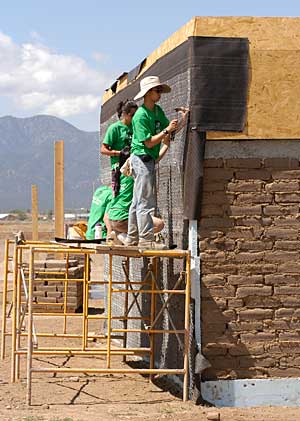With the recent slowdown in design and construction activity, many architects are losing their jobs. While volunteering won’t pay the bills, experts say it’s a good way to stay active in the profession while hunting for employment. It might even provide architects a chance to strengthen their skill set and expand their professional network. “The idea is visibility,” says Carol Metzner of the Metzner Group, a recruiting agency for architects and engineers. She adds that volunteer positions could also lead to full-time employment.

Photo © Steffan Hacker/courtesy Habitat for Humanity
Habitat for Humanity volunteers affix wire to the exterior of a house in New Mexico.
Many nonprofit organizations require the help of design professionals to deliver on a wide range of activities. Here are a few volunteer opportunities that may be of particular interest to architects.
Architecture for Humanity actively seeks volunteers to implement architectural solutions to humanitarian crises on a full-time, part-time, and short-term basis. Register on the Web site, and the organization will match you with a client. Some projects are completed in the field, while others can be completed remotely from your home or office. Architecture for Humanity also posts specific volunteer opportunities online.
Habitat for Humanity has numerous volunteer programs in both construction and administration. To volunteer for projects in your own community, connect with your nearest branch. Or, volunteer for construction work in other countries through the Global Village program, where you’ll work alongside members of the host community to build housing. The organization also welcomes volunteers for a wide variety of office-based jobs, including the drafting of plans, at its headquarters in Americus, Georgia. More specialized programs are listed online.
Architects Without Borders is a network of architects across the globe who provide humanitarian relief in the face of economic crisis, natural disaster, and human conflict. Volunteers undertake a wide variety of activities as needs arise. To contact the umbrella organization, visit the group’s Web site or e-mail architectswithoutborders@gmail.com. The Seattle and Oregon chapters are particularly active, and welcome volunteers for everything from designing and building shelter to administrative work.
The American Institute of Architecture Students’ Freedom by Design program offers modest design and construction solutions to improve accessibility for the elderly and disabled. Architects are needed to serve as volunteer mentors for students in communities across the country. Information on the program is available at the program Web site.
The American Institute of Architects encourages volunteering in numerous areas. The AIA Center for Communities by Design runs Regional/Urban Design Assistance Teams (R/UDATs) and Sustainable Design Assistance Teams (SDATs), which pull together groups of volunteers to offer design solutions to specific communities, as well as the Disaster Assistance Program. Volunteers can also work as leaders for AIA Knowledge Communities. A wide variety of community service programs are also managed by local and state components of the AIA, so check with your regional office for its latest activities.
Local chapters of DOCOMOMO, “the international working party for documentation and conservation of buildings, sites and neighborhoods of the modern movement,” often require additional volunteers to help with advocacy, building registration, communications, and public tours and events. Find your local chapter on the organization’s Web site. Architects interested in volunteering with the New York chapter should e-mail info@docomomo-nytri.org.
The National Trust For Historic Preservation runs its own volunteer programs (it is currently sponsoring work weeks in New Orleans) in addition to maintaining a list of locally focused, preservation-related volunteering opportunities. Visit the trust’s Web site and then search by state.
Public Architecture runs the 1% program, which encourages architectural offices to dedicate 1 percent of their billable hours to completing pro bono work for nonprofit organizations. However, Public Architecture also requires volunteers to help with the design of specific projects and to perform a range of jobs related to program delivery. Visit the Public Architecture Web site to see current opportunities.
The National Building Museum in Washington, DC, relies on volunteers for behind-the-scenes activities, cataloguing the collection, tours, and many other activities. For more information and to apply, visit the museum’s Web site.
Consider volunteering to help out at a local architectural landmark. For instance, at Frank Lloyd Wright’s Fallingwater, the Western Pennsylvania Conservancy welcomes volunteers in a wide range of capacities, from site guides to building maintenance teams.
The Recent Past Preservation Network, which promotes the preservation of the modern built environment, frequently asks volunteers to write editorial pieces and letters, develop case studies, collect photos and news clippings, help expand the organization’s Web site, and generally get the word out about at-risk buildings. More information on volunteering is available here.
A wide range of volunteering opportunities is available through the AmeriCorps VISTA program, including work terms with housing organizations. Volunteers make a yearlong, full-time commitment to the program and receive a living allowance and health benefits as well as a small stipend at the end of the year. Specific volunteer opportunities are searchable by state on the Web site.
In New York City, VolunteerNYC.org maintains a listing of hundreds of active volunteer opportunities. While these are open to the general public, architects may be particularly interested in activities related to housing, parks, the environment, and the arts. The Web site allows users to search by location, topic, and keyword.
Also in New York, the Center for Architecture has launched a series of meetings and workshops under its Not Business as Usual initiative. On February 25, it hosted a fair with representatives from nonprofit organizations, among others, who shared information about volunteering and other opportunities. Learn more.

Post a comment to this article
Report Abusive Comment